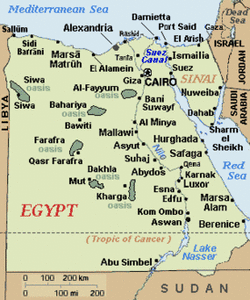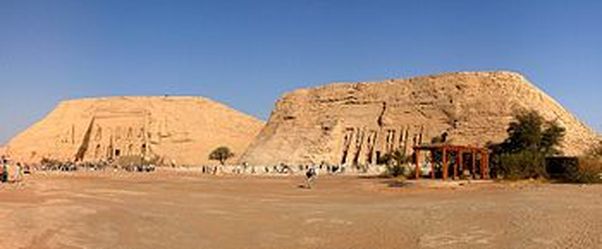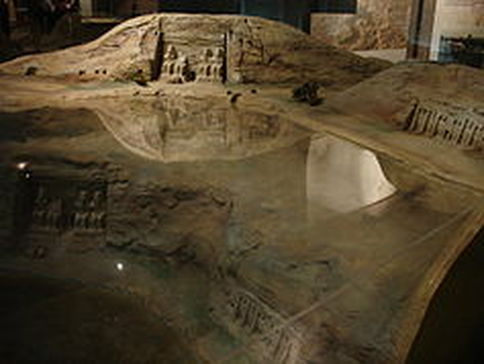31 March – 1 April, Friday
We explored the area a little, drove to the Aswan dam decided that we would like to visit Abu Simbel, a temple in the Nubian Desert built by Ramesses II. It is only possible to go with a guarded convoy – the first one leaves at 3am and the second 11 am. We find a spot by the river, pitch one tent for Willie and me, and the boys sleep in the car till 2:30 when we get up, pack up and drive to the convoy meeting point.
3:45 tour buses and mini-vans arrive filled with tourists. This is definitely the most tourists that we’ve seen since we’ve been in Egypt. We are not exactly sure what convoy means, because once we have the green light to leave each one goes their own pace and maybe even own way! The trip through the desert is beautiful and we are so close to the border of Sudan at one point – 50 miles away if not closer.
Map: Wikipedia
We explored the area a little, drove to the Aswan dam decided that we would like to visit Abu Simbel, a temple in the Nubian Desert built by Ramesses II. It is only possible to go with a guarded convoy – the first one leaves at 3am and the second 11 am. We find a spot by the river, pitch one tent for Willie and me, and the boys sleep in the car till 2:30 when we get up, pack up and drive to the convoy meeting point.
3:45 tour buses and mini-vans arrive filled with tourists. This is definitely the most tourists that we’ve seen since we’ve been in Egypt. We are not exactly sure what convoy means, because once we have the green light to leave each one goes their own pace and maybe even own way! The trip through the desert is beautiful and we are so close to the border of Sudan at one point – 50 miles away if not closer.
Map: Wikipedia
Abu Simbel:
Not only is Abu Simbel steeped in ages of history, but it also boasts with quite a miraculous “modern” history. Abu Simbel is a Unesco World Heritage Site and refers to 2 massive temples built in the Nubian Desert by Pharaoh Ramesses II during the 13th century before Christ. The twin temples were built to commemorate Ramesses’ victory at Kadesh, to intimidate his Nubian neighbors and to serve as a lasting monument to himself and his queen, Nefertari. The temples fell into disuse with the passage of time and by the 6th century BC was long forgotten and covered in sand. A Swiss orientalist re-discovered the temples in 1813 under the guidance of a young, local boy, Abu Simbel, who has seen the temples emerge as sand shifted during sandstorms. Eventually the complex was named after him.
Picture: Wikipedia
Not only is Abu Simbel steeped in ages of history, but it also boasts with quite a miraculous “modern” history. Abu Simbel is a Unesco World Heritage Site and refers to 2 massive temples built in the Nubian Desert by Pharaoh Ramesses II during the 13th century before Christ. The twin temples were built to commemorate Ramesses’ victory at Kadesh, to intimidate his Nubian neighbors and to serve as a lasting monument to himself and his queen, Nefertari. The temples fell into disuse with the passage of time and by the 6th century BC was long forgotten and covered in sand. A Swiss orientalist re-discovered the temples in 1813 under the guidance of a young, local boy, Abu Simbel, who has seen the temples emerge as sand shifted during sandstorms. Eventually the complex was named after him.
Picture: Wikipedia
As water started to rise from the Nile as a result of the Aswan dam complex the monuments were under threat to be submerged by water and an international salvage campaign began. A multinational team of professionals started the salvage project in 1964 under the banner of UNESCO. It took 4 years to carefully and skillfully cut up the entire site into massive blocks, dismantle, lift and relocate it to the new above water location. (65m higher and 200m further back).
We arrive in Abu Simbel village convoy-less!?, find parking in the shade for the ‘kelp’(Sammie) in the car, maneuver our way through the tourists traps quite skillfully – almost 4 weeks in Egypt have trained us well, “No, we don’t need postcards, water, hats, suntan-lotion, … or a guide!” That one did not go over very well, because after Willie bought the tickets do we realize the price include a guide! and now they tell us to go find a guide in the bush, because we said we do not need a guide. We have to check ourselves, because all 4 of us have less tolerance with the constant hassling and bickering you have to deal with almost everywhere.
We walk around the man-made hill-mountain surrounded by the dam and then suddenly there they sit: 4 humongous carved-out of stone statues of Ramesses II! It is almost unbelievable – the size, the dimensions, and the age…and added to what is already a miracle the modern-day miracle of successfully moving the colossuses from one location to another!
As in the Valley of the Kings we are not allowed to take any pictures inside of the temple. The hieroglyphics are stunning and well-preserved except for the graffiti of visitors in the 1800’s whose names are now immortalized next to ancient writing dating from before Christ.
Ramesses II also built a temple, on smaller scale, for his beloved and beautiful wife – Queen Nefartati. The hieroglyphics are remarkable and of a kind that we’ve not seen before. It is a very warm day and the 4 of us are like drowsy flies. We drive to the town, buy provisions for the evening meal and eat our lunch next to a gas station in semi-shade. We are not allowed to go back to Aswan without the convoy which means we have to wait till 4pm!
Click on Play to Start:
We walk around the man-made hill-mountain surrounded by the dam and then suddenly there they sit: 4 humongous carved-out of stone statues of Ramesses II! It is almost unbelievable – the size, the dimensions, and the age…and added to what is already a miracle the modern-day miracle of successfully moving the colossuses from one location to another!
As in the Valley of the Kings we are not allowed to take any pictures inside of the temple. The hieroglyphics are stunning and well-preserved except for the graffiti of visitors in the 1800’s whose names are now immortalized next to ancient writing dating from before Christ.
Ramesses II also built a temple, on smaller scale, for his beloved and beautiful wife – Queen Nefartati. The hieroglyphics are remarkable and of a kind that we’ve not seen before. It is a very warm day and the 4 of us are like drowsy flies. We drive to the town, buy provisions for the evening meal and eat our lunch next to a gas station in semi-shade. We are not allowed to go back to Aswan without the convoy which means we have to wait till 4pm!
Click on Play to Start:



 RSS Feed
RSS Feed
